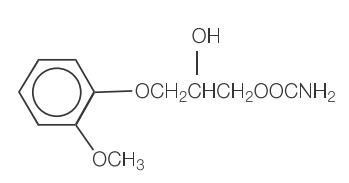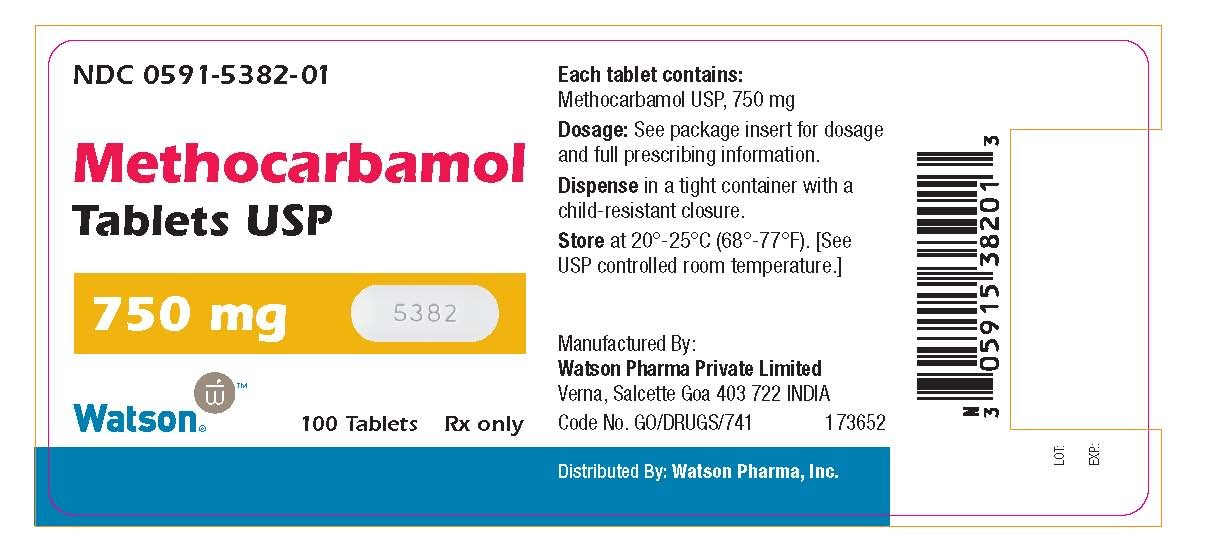Methocarbamol
Methocarbamol Tablets USPRevised: September 2008Rx only173752
FULL PRESCRIBING INFORMATION: CONTENTS*
- METHOCARBAMOL DESCRIPTION
- Clinical Pharmacology
- METHOCARBAMOL INDICATIONS AND USAGE
- METHOCARBAMOL CONTRAINDICATIONS
- WARNINGS
- PRECAUTIONS
- METHOCARBAMOL ADVERSE REACTIONS
- OVERDOSAGE
- METHOCARBAMOL DOSAGE AND ADMINISTRATION
- HOW SUPPLIED
- Principal Display Panel
- Principal Display Panel
FULL PRESCRIBING INFORMATION
Rx only
METHOCARBAMOL DESCRIPTION
Methocarbamol, a carbamate derivative of gualfenesin, is a central nervous system (CNS) depressant with sedative and musculoskeletal relaxant properties.
The chemical name of methocarbamol is a 3-(2 methoxyphenoxy)-1,2-propanediol 1-carbamate. The structural formula is shown below:

C11H15NO5 M.W. 241.24
Methocarbamol is a white powder, sparingly soluble in water and chloroform, soluble in alcohol (only with heating) and propylene glycol, and insoluble in benzene and n-hexane.
Methocarbamol Tablets USP 500 mg and 750 mg, contain the follwing inactive ingredients: colloidal silicon dioxide, magnesium stearate, pregelatinized starch, sodium starch glycolate and stearic acid.
Clinical Pharmacology
The mechanism of action of methocarbamol in humans has not been established, but may be due to general central nervous system (CNS) depression. It has no direct action on the contractile mechanism of striated muscle, the motor end plate or the nerve fiber.
Pharmacokinetics
In healthy volunteers, the plasma clearance of methocarbamol ranges between 0.20 and 0.80 L/h/kg, the mean plasma elimination half-life ranges between 1 and 2 hours, and the plasma protein binding ranges between 46% and 50%.
Methocarbamol is metabolized via dealkylation and hydroxylation. Conjugation of methocarbamol also is likely. Essentially all methocarbamol metabolites are eliminated in the urine. Small amounts of unchanged methocarbamol also are excreted in the urine.
Special populations
Elderly
The mean (± SD) elimination half-life of methocarbamol in elderly healthy volunteers (mean (± SD) age, 69 (± 4) years) was slightly prolonged compared to a younger (mean (± SD) age, 53.3 (± 8.8) years), healthy population (1.5 (± 0.4) hours versus 1.1 (± 0.27) hours, respectively). The fraction of bound methocarbamol was slightly decreased in the elderly versus younger volunteers (41 to 43% versus 46 to 50%, respectively).
Renally impaired
The clearance of methocarbamol in 8 renally-impaired patients on maintenance hemodialysis was reduced about 40% compared to 17 normal subjects, although the mean (± SD) elimination half-life in these two groups was similar: 1.2 (± 0.6) versus 1.1 (± 0.3) hours, respectively.
Hepatically impaired
In 8 patients with cirrhosis secondary to alcohol abuse, the mean total clearance of methocarbamol was reduced approximately 70% compared to that obtained in 8 age- and weight-matched normal subjects. The mean (± SD) elimination half-life in the cirrhotic patients and the normal subjects was 3.38 (± 1.62) hours and 1.11 (± 0.27) hours, respectively. The percent of methocarbamol bound to plasma proteins was decreased to approximately 40 to 45% compared to 46 to 50% in the normal subjects.
METHOCARBAMOL INDICATIONS AND USAGE
Methocarbamol tablets are indicated as an adjunct to rest, physical therapy, and other measures for the relief of discomfort associated with acute, painful musculoskeletal conditions. The mode of action of methocarbamol has not been clearly identified, but may be related to its sedative properties. Methocarbamol does not directly relax tense skeletal muscles in man.
METHOCARBAMOL CONTRAINDICATIONS
Methocarbamol tablets are contraindicated in patients hypersensitive to methocarbamol or to any of the tablet components.
WARNINGS
Since methocarbamol may possess a general CNS depressant effect, patients receiving methocarbamol should be cautioned about combined effects with alcohol and other CNS depressants.
Safe use of methocarbamol has not been established with regard to possible adverse effects upon fetal development. There have been reports of fetal and congenital abnormalities following in utero exposure to methocarbamol. Therefore, methocarbamol should not be used in women who are or may become pregnant and particularly during early pregnancy unless in the judgment of the physician the potential benefits outweigh the possible hazards (see PRECAUTIONS, Pregnancy ).
Use In Activities Requiring Mental Alertness
Methocarbamol may impair mental and/or physical abilities required for performance of hazardous tasks, such as operating machinery or driving a motor vehicle. Patients should be cautioned about operating machinery, including automobiles, until they are reasonably certain that methocarbamol therapy does not adversely affect their ability to engage in such activities.
PRECAUTIONS
Information for Patients
Patients should be cautioned that methocarbamol may cause drowsiness or dizziness, which may impair their ability to operate motor vehicles or machinery.
Because methocarbamol may possess a general CNS-depressant effect, patients should be cautioned about combined effects with alcohol and other CNS depressants.
Drug Interactions
See WARNINGS and PRECAUTIONS for interaction with CNS drugs and alcohol.
Methocarbamol may inhibit the effect of pyridostigmine bromide. Therefore, methocarbamol should be used with caution in patients with myasthenia gravis receiving anticholinesterase agents.
Drug/Laboratory Test Interactions
Methocarbamol may cause a color interference in certain screening tests for 5-hydroxyindoleacetic acid (5-HIAA) using nitrosonaphthol reagent and in screening tests for urinary vanillylmandelic acid (VMA) using the Gitlow method.
Carcinogenesis, Mutagenesis, Impairment of Fertility
Long-term studies to evaluate the carcinogenic potential of methocarbamol have not been performed. No studies have been conducted to assess the effect of methocarbamol on mutagenesis or its potential to impair fertility.
Pregnancy
Teratogenic Effects — Pregnancy Category C
Animal reproduction studies have not been conducted with methocarbamol. It is also not known whether methocarbamol can cause fetal harm when administered to a pregnant woman or can affect reproduction capacity. Methocarbamol should be given to a pregnant woman only if clearly needed.
Safe use of methocarbamol has not been established with regard to possible adverse effects upon fetal development. There have been reports of fetal and congenital abnormalities following in utero exposure to methocarbamol. Therefore, methocarbamol should not be used in women who are or may become pregnant and particularly during early pregnancy unless in the judgment of the physician the potential benefits outweigh the possible hazards (see WARNINGS ).
Nursing Mothers
Methocarbamol and/or its metabolites are excreted in the milk of dogs; however, it is not known whether methocarbamol or its metabolites are excreted in human milk. Because many drugs are excreted in human milk, caution should be exercised when methocarbamol is administered to a nursing woman.
Pediatric Use
Safety and effectiveness of methocarbamol in pediatric patients below the age of 16 have not been established.
METHOCARBAMOL ADVERSE REACTIONS
Adverse reactions reported coincident with the administration of methocarbamol include:
Body as a whole: Anaphylactic reaction, angioneurotic edema, fever, headache
Cardiovascular system: Bradycardia, flushing, hypotension, syncope, thrombophlebitis
Digestive system: Dyspepsia, jaundice (including cholestatic jaundice), nausea and vomiting
Hemic and lymphatic system: Leukopenia
Immune system: Hypersensitivity reactions
Nervous system: Amnesia, confusion, diplopia, dizziness or lightheadedness, drowsiness, insomnia, mild muscular incoordination, nystagmus, sedation, seizures (including grand mal), vertigo
Skin and special senses: Blurred vision, conjunctivitis, nasal congestion, metallic taste, pruritus, rash, urticaria
OVERDOSAGE
Limited information is available on the acute toxicity of methocarbamol. Overdose of methocarbamol is frequently in conjunction with alcohol or other CNS depressants and includes the following symptoms: nausea, drowsiness, blurred vision, hypotension, seizures, and coma.
In post-marketing experience, deaths have been reported with an overdose of methocarbamol alone or in the presence of other CNS depressants, alcohol or psychotropic drugs.
Treatment
Management of overdose includes symptomatic and supportive treatment. Supportive measures include maintenance of an adequate airway, monitoring urinary output and vital signs, and administration of intravenous fluids if necessary. The usefulness of hemodialysis in managing overdose is unknown.
METHOCARBAMOL DOSAGE AND ADMINISTRATION
500 mg - Adults:
initial dosage, 3 tablets q.i.d.; maintenance dosage, 2 tablets q.i.d.
750 mg - Adults:
initial dosage, 2 tablets q.i.d.; maintenance dosage 1 tablet q.4h or 2 tablets t.i.d.
Six grams a day are recommended for the first 48 to 72 hours of treatment. (For severe conditions 8 grams a day may be administered). Thereafter, the dosage can usually be reduced to approximately 4 grams a day.
HOW SUPPLIED
Methocarbamol Tablets USP 500 mg are scored, round, white tablets imprinted DAN DAN and 5381 supplied in bottles of 100 and 500.
Methocarbamol Tablets USP 750 mg are scored, capsule shaped, white tablets imprinted DAN DAN and 5382 supplied in bottles of 100 and 500.
Dispense in a tight container with a child-resistant closure.
Store at 20°-25°C (68°-77°F). [See USP controlled room temperature.]
Manufactured by:
Watson Pharma Private Ltd.
Verna, Salcette Goa 403 722 INDIA
Distributed By:
Watson Pharma Inc.
Corona, CA 92880 USA
Revised : September 2008
0908B 173752
Principal Display Panel
NDC 0591-5381-01
Methocarbamol
Tablets USP
500 mg
100 Tablets Rx only
Each tablet contains:
Methocarbamol USP, 500 mg
Dosage : See package insert for dosage
and full prescribing information.
Dispense in a tight container with a
child-resistant closure.
Store at 20ºC-25ºC (68º-77ºF).[See
USP controlled room temperature.]
Manufactured By:
Watson Pharma Private Limited
Verna, Salcette Goa 403 722 INDIA
Code No. GO/DRUGS/741 173650
Distributed by : Watson Pharma, Inc.

Principal Display Panel
NDC 0591-5382-01
Methocarbamol
Tablets USP
750 mg
100 Tablets Rx only
Each tablet contains:
Methocarbamol USP, 750 mg
Dosage : See package insert for dosage
and full prescribing information.
Dispense in a tight container with a
child-resistant closure.
Store at 20ºC-25ºC (68º-77ºF).[See
USP controlled room temperature.]
Manufactured By:
Watson Pharma Private Limited
Verna, Salcette Goa 403 722 INDIA
Code No. GO/DRUGS/741 173652
Distributed by : Watson Pharma, Inc.

MethocarbamolMethocarbamol TABLET
| |||||||||||||||||||||||||||||||||||||||||||||||||||||||||||||||||||||||||||||||||
MethocarbamolMethocarbamol TABLET
| |||||||||||||||||||||||||||||||||||||||||||||||||||||||||||||||||||||||||||||||||